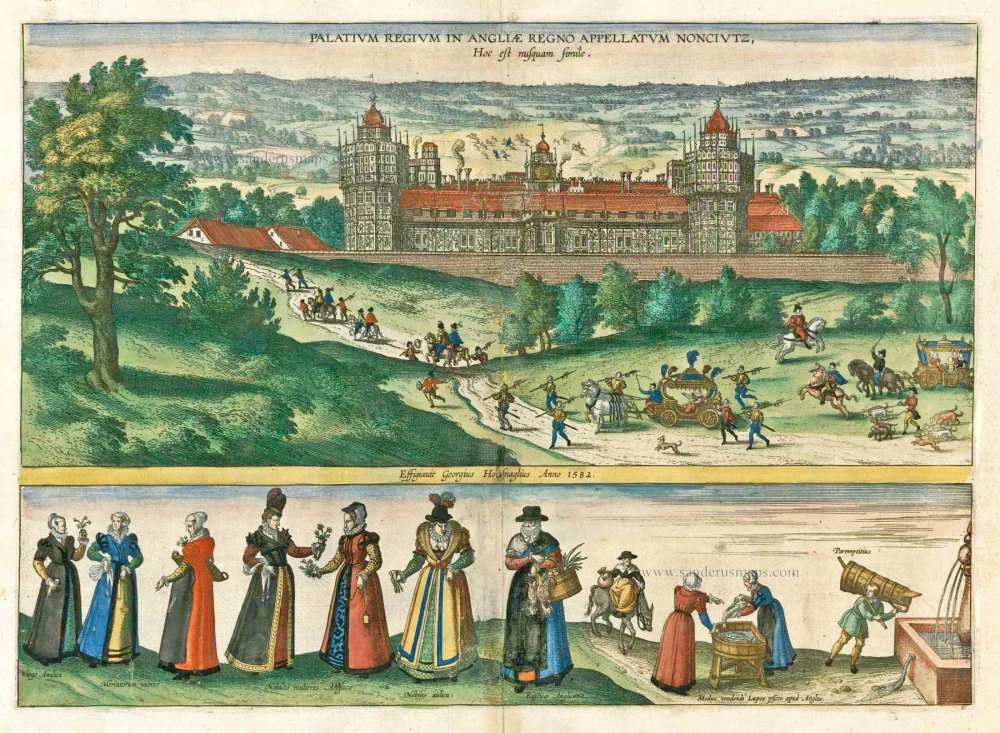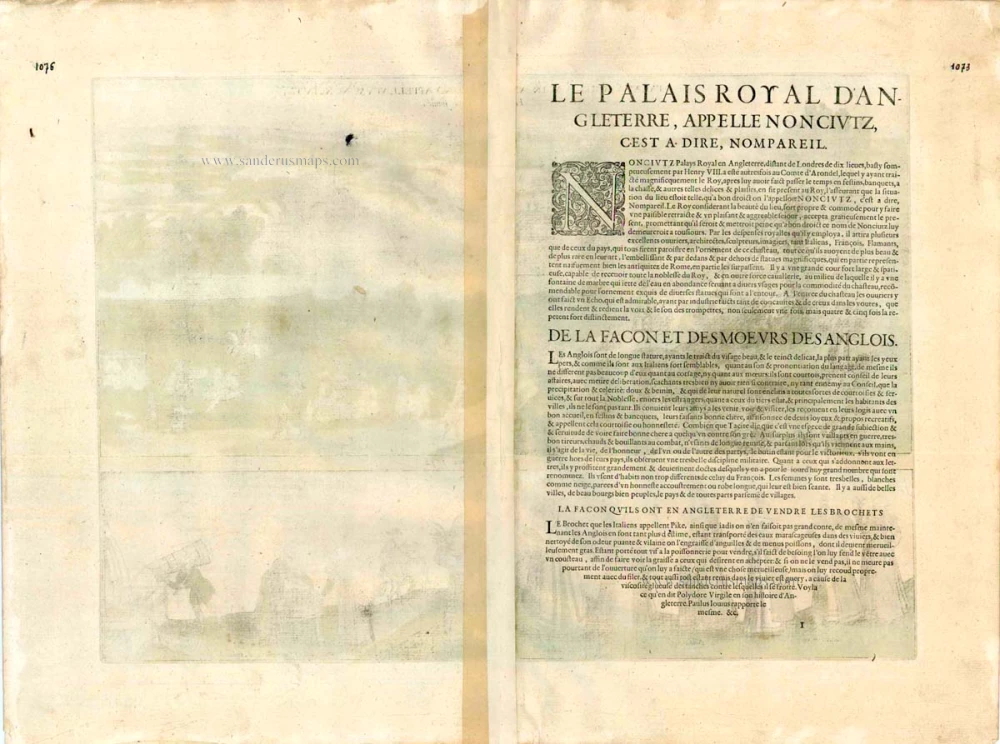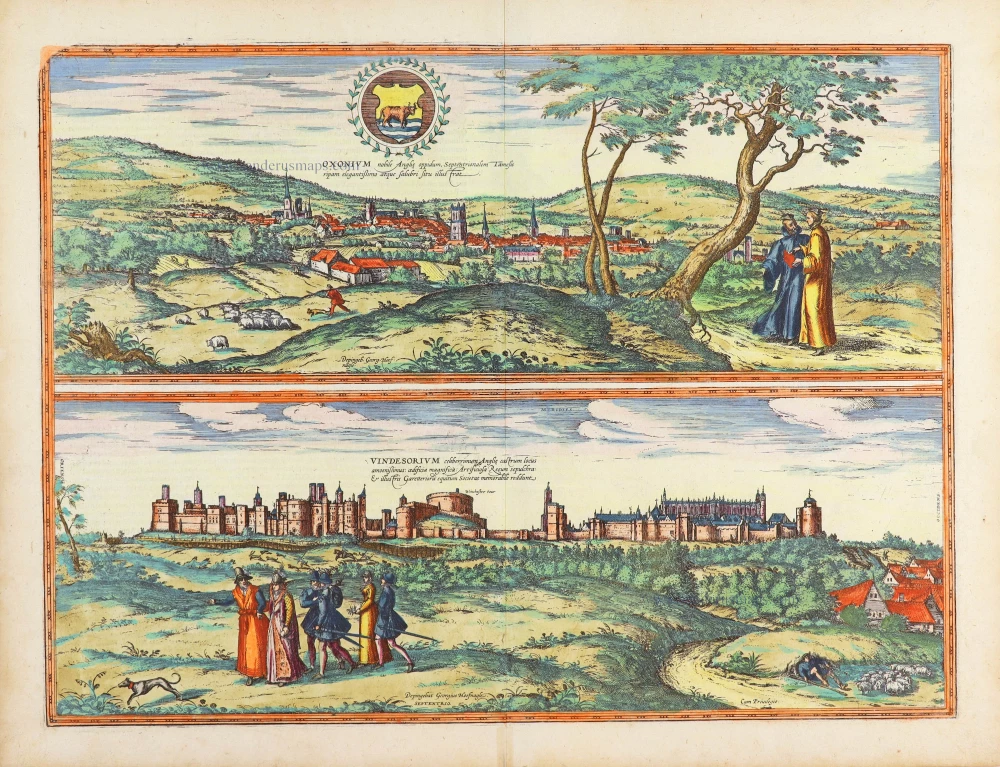Old, antique map - View of Nonsuch Palace at Hampton Court by Braun and Hogenberg, after G. Hoefnagel. c. 1610
"Drawn by Georg Hoefnagel in the year 1582."
TRANSLATION OF CAPTION: The Royal palace in the Kingdom of England, called Nonsuch. Nowhere is there anything the like.
COMMENTARY BY BRAUN (on verso): "The royal palace in England Nonsuch, ten miles away from London, was magnificently built by Henry VIII. [...] The construction of this complex is so astonishing that it deserves its name Nonsuch, i.e. "none the like". [...] Many excellent craftsmen, master builders, stonecutters and sculptors, Italians, French, Dutch and English, were employed here at the King's expense. In their decoration of the palace, which is adorned inside and out with handsome sculptures, these craftsmen have created a particular work of art that not just equals the antiquities of Rome, but in part even surpasses them."
The engraving shows the front façade of Nonsuch Palace as viewed from the south. Commenced in 1538, the palace numbered amongst Henry VIII's grandest building projects and played an important role in introducing Renaissance architecture in England. The Tudor king has Nonsuch built in the County of Surrey, close to one of his favourite hunting grounds; accordingly, a hunting scene can be made out on the hillside behind the palace. The palace was the favourite residence of Elizabeth I; she can be seen in the engraving in a splendid carriage accompanied by a large retinue. In 1670 Charles II gave Nonsuch to his mistress, Barbara Palmer. In 1682, with the king's permission, she had the palace demolished and sold off the building materials in order to settle her gambling debts. The lower illustration shows costumed figures from the English nobility and peasantry (from left to right:) English maiden / Merchant's wives / English noblewomen / Noble lady-in-waiting / English peasant woman / The bass that are sold by the English / Water-carier. (Taschen)
Braun G. & Hogenberg F. and the Civitates Orbis Terrarum.
The Civitates Orbis Terrarum, also known as the 'Braun & Hogenberg', is a six-volume town atlas and the most excellent book of town views and plans ever published: 363 engravings, sometimes beautifully coloured. It was one of the best-selling works in the last quarter of the 16th century. Georg Braun, a skilled writer, wrote the text accompanying the plans and views on the verso. Many plates were engraved after the original drawings of a professional artist, Joris Hoefnagel (1542-1600). The first volume was published in Latin in 1572 and the sixth in 1617. Frans Hogenberg, a talented engraver, created the tables for volumes I through IV, and Simon van den Neuwel made those for volumes V and VI. Other contributors were cartographers Daniel Freese and Heinrich Rantzau, who provided valuable geographical information. Works by Jacob van Deventer, Sebastian Münster, and Johannes Stumpf were also used as references. Translations appeared in German and French, making the atlas accessible to a wider audience.
Since its original publication of volume 1 in 1572, the Civitates Orbis Terrarum has left an indelible mark on the history of cartography. The first volume was followed by seven more editions in 1575, 1577, 1582, 1588, 1593, 1599, and 1612. Vol.2, initially released in 1575, saw subsequent editions in 1597 and 1612. The subsequent volumes, each a treasure trove of historical insights, graced the world in 1581, 1588, 1593, 1599, and 1606. The German translation of the first volume, a testament to its widespread appeal, debuted in 1574, followed by the French edition in 1575.
Several printers were involved: Theodor Graminaeus, Heinrich von Aich, Gottfried von Kempen, Johannis Sinniger, Bertram Buchholtz, and Peter von Brachel, all of whom worked in Cologne.
Georg Braun (1541-1622)
Georg Braun, the author of the text accompanying the plans and views in the Civitates Orbis Terrarum, was born in Cologne in 1541. After his studies in Cologne, he entered the Jesuit Order as a novice, indicating his commitment to learning and intellectual pursuits. In 1561, he obtained his bachelor's degree; in 1562, he received his Magister Artium, further demonstrating his academic achievements. Although he left the Jesuit Order, he continued his studies in theology, gaining a licentiate in theology. His theological background likely influenced the content and tone of the text in the Civitates Orbis Terrarum, adding a unique perspective to the work.
Frans Hogenberg (1535-1590)
Frans Hogenberg was a Flemish and German painter, engraver, and mapmaker. He was born in Mechelen as the son of Nicolaas Hogenberg.
By the end of the 1560s, Frans Hogenberg was employed upon Abraham Ortelius's Theatrum Orbis Terrarum, published in 1570; he is named an engraver of numerous maps. In 1568, he was banned from Antwerp by the Duke of Alva and travelled to London, where he stayed a few years before emigrating to Cologne. He immediately embarked on his two most important works, the Civitates, published in 1572 and the Geschichtsblätter, which appeared in several series from 1569 until about 1587.
Thanks to large-scale projects like the Geschichtsblätter and the Civitates, Hogenberg's social circumstances improved with each passing year. He died as a wealthy man in Cologne in 1590.
Palatium Regium in Angliae Regno Appelatum Nonciutz
Item Number: 16710 Authenticity Guarantee
Category: Antique maps > Europe > British Isles
Old, antique map - View of Nonsuch Palace at Hampton Court by Braun and Hogenberg, after G. Hoefnagel.
"Drawn by Georg Hoefnagel in the year 1582."
TRANSLATION OF CAPTION: The Royal palace in the Kingdom of England, called Nonsuch. Nowhere is there anything the like.
COMMENTARY BY BRAUN (on verso): "The royal palace in England Nonsuch, ten miles away from London, was magnificently built by Henry VIII. [...] The construction of this complex is so astonishing that it deserves its name Nonsuch, i.e. "none the like". [...] Many excellent craftsmen, master builders, stonecutters and sculptors, Italians, French, Dutch and English, were employed here at the King's expense. In their decoration of the palace, which is adorned inside and out with handsome sculptures, these craftsmen have created a particular work of art that not just equals the antiquities of Rome, but in part even surpasses them."
The engraving shows the front façade of Nonsuch Palace as viewed from the south. Commenced in 1538, the palace numbered amongst Henry VIII's grandest building projects and played an important role in introducing Renaissance architecture in England. The Tudor king has Nonsuch built in the County of Surrey, close to one of his favourite hunting grounds; accordingly, a hunting scene can be made out on the hillside behind the palace. The palace was the favourite residence of Elizabeth I; she can be seen in the engraving in a splendid carriage accompanied by a large retinue. In 1670 Charles II gave Nonsuch to his mistress, Barbara Palmer. In 1682, with the king's permission, she had the palace demolished and sold off the building materials in order to settle her gambling debts. The lower illustration shows costumed figures from the English nobility and peasantry (from left to right:) English maiden / Merchant's wives / English noblewomen / Noble lady-in-waiting / English peasant woman / The bass that are sold by the English / Water-carier. (Taschen)
Date of the first edition: 1596
Date of this map: c. 1610
Copper engraving
Size: 32 x 43cm (12.5 x 16.8 inches)
Verso text: French
Condition: Contemporary coloured, lower centrefold split restored, some staining at lower centre.
Condition Rating: B
References: Van der Krogt 4, 3105; Taschen, Braun and Hogenberg, p.366.
From: Théâtre des Principales Villes de tout l'Univers. Tome 5. c. 1610.
"Drawn by Georg Hoefnagel in the year 1582."
TRANSLATION OF CAPTION: The Royal palace in the Kingdom of England, called Nonsuch. Nowhere is there anything the like.
COMMENTARY BY BRAUN (on verso): "The royal palace in England Nonsuch, ten miles away from London, was magnificently built by Henry VIII. [...] The construction of this complex is so astonishing that it deserves its name Nonsuch, i.e. "none the like". [...] Many excellent craftsmen, master builders, stonecutters and sculptors, Italians, French, Dutch and English, were employed here at the King's expense. In their decoration of the palace, which is adorned inside and out with handsome sculptures, these craftsmen have created a particular work of art that not just equals the antiquities of Rome, but in part even surpasses them."
The engraving shows the front façade of Nonsuch Palace as viewed from the south. Commenced in 1538, the palace numbered amongst Henry VIII's grandest building projects and played an important role in introducing Renaissance architecture in England. The Tudor king has Nonsuch built in the County of Surrey, close to one of his favourite hunting grounds; accordingly, a hunting scene can be made out on the hillside behind the palace. The palace was the favourite residence of Elizabeth I; she can be seen in the engraving in a splendid carriage accompanied by a large retinue. In 1670 Charles II gave Nonsuch to his mistress, Barbara Palmer. In 1682, with the king's permission, she had the palace demolished and sold off the building materials in order to settle her gambling debts. The lower illustration shows costumed figures from the English nobility and peasantry (from left to right:) English maiden / Merchant's wives / English noblewomen / Noble lady-in-waiting / English peasant woman / The bass that are sold by the English / Water-carier. (Taschen)
Braun G. & Hogenberg F. and the Civitates Orbis Terrarum.
The Civitates Orbis Terrarum, also known as the 'Braun & Hogenberg', is a six-volume town atlas and the most excellent book of town views and plans ever published: 363 engravings, sometimes beautifully coloured. It was one of the best-selling works in the last quarter of the 16th century. Georg Braun, a skilled writer, wrote the text accompanying the plans and views on the verso. Many plates were engraved after the original drawings of a professional artist, Joris Hoefnagel (1542-1600). The first volume was published in Latin in 1572 and the sixth in 1617. Frans Hogenberg, a talented engraver, created the tables for volumes I through IV, and Simon van den Neuwel made those for volumes V and VI. Other contributors were cartographers Daniel Freese and Heinrich Rantzau, who provided valuable geographical information. Works by Jacob van Deventer, Sebastian Münster, and Johannes Stumpf were also used as references. Translations appeared in German and French, making the atlas accessible to a wider audience.
Since its original publication of volume 1 in 1572, the Civitates Orbis Terrarum has left an indelible mark on the history of cartography. The first volume was followed by seven more editions in 1575, 1577, 1582, 1588, 1593, 1599, and 1612. Vol.2, initially released in 1575, saw subsequent editions in 1597 and 1612. The subsequent volumes, each a treasure trove of historical insights, graced the world in 1581, 1588, 1593, 1599, and 1606. The German translation of the first volume, a testament to its widespread appeal, debuted in 1574, followed by the French edition in 1575.
Several printers were involved: Theodor Graminaeus, Heinrich von Aich, Gottfried von Kempen, Johannis Sinniger, Bertram Buchholtz, and Peter von Brachel, all of whom worked in Cologne.
Georg Braun (1541-1622)
Georg Braun, the author of the text accompanying the plans and views in the Civitates Orbis Terrarum, was born in Cologne in 1541. After his studies in Cologne, he entered the Jesuit Order as a novice, indicating his commitment to learning and intellectual pursuits. In 1561, he obtained his bachelor's degree; in 1562, he received his Magister Artium, further demonstrating his academic achievements. Although he left the Jesuit Order, he continued his studies in theology, gaining a licentiate in theology. His theological background likely influenced the content and tone of the text in the Civitates Orbis Terrarum, adding a unique perspective to the work.
Frans Hogenberg (1535-1590)
Frans Hogenberg was a Flemish and German painter, engraver, and mapmaker. He was born in Mechelen as the son of Nicolaas Hogenberg.
By the end of the 1560s, Frans Hogenberg was employed upon Abraham Ortelius's Theatrum Orbis Terrarum, published in 1570; he is named an engraver of numerous maps. In 1568, he was banned from Antwerp by the Duke of Alva and travelled to London, where he stayed a few years before emigrating to Cologne. He immediately embarked on his two most important works, the Civitates, published in 1572 and the Geschichtsblätter, which appeared in several series from 1569 until about 1587.
Thanks to large-scale projects like the Geschichtsblätter and the Civitates, Hogenberg's social circumstances improved with each passing year. He died as a wealthy man in Cologne in 1590.





